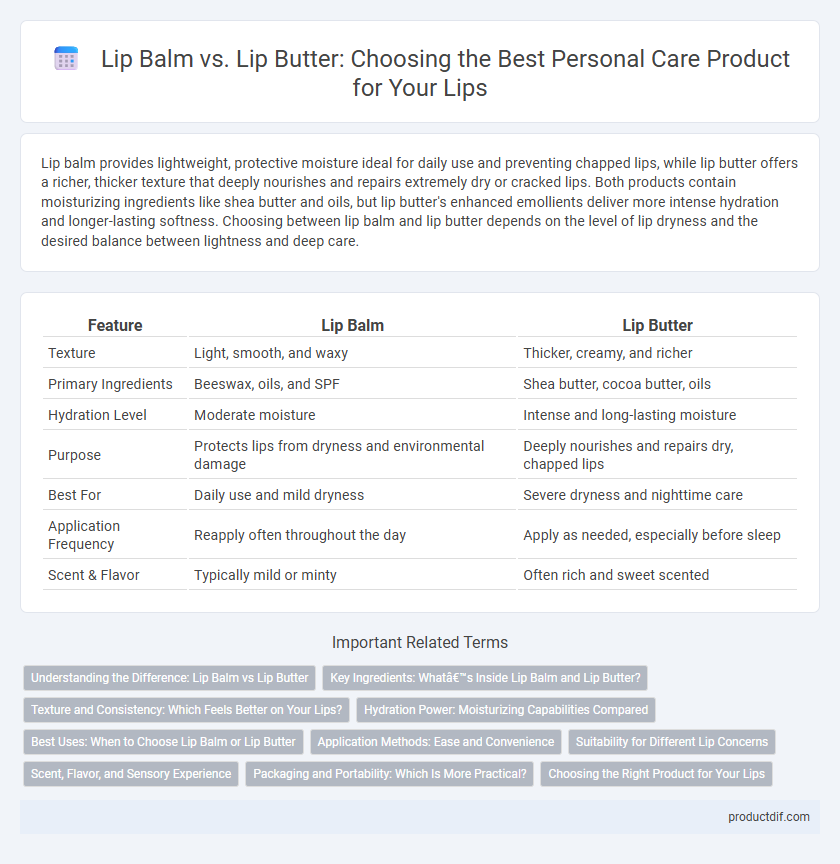Lip balm provides lightweight, protective moisture ideal for daily use and preventing chapped lips, while lip butter offers a richer, thicker texture that deeply nourishes and repairs extremely dry or cracked lips. Both products contain moisturizing ingredients like shea butter and oils, but lip butter's enhanced emollients deliver more intense hydration and longer-lasting softness. Choosing between lip balm and lip butter depends on the level of lip dryness and the desired balance between lightness and deep care.
Table of Comparison
| Feature | Lip Balm | Lip Butter |
|---|---|---|
| Texture | Light, smooth, and waxy | Thicker, creamy, and richer |
| Primary Ingredients | Beeswax, oils, and SPF | Shea butter, cocoa butter, oils |
| Hydration Level | Moderate moisture | Intense and long-lasting moisture |
| Purpose | Protects lips from dryness and environmental damage | Deeply nourishes and repairs dry, chapped lips |
| Best For | Daily use and mild dryness | Severe dryness and nighttime care |
| Application Frequency | Reapply often throughout the day | Apply as needed, especially before sleep |
| Scent & Flavor | Typically mild or minty | Often rich and sweet scented |
Understanding the Difference: Lip Balm vs Lip Butter
Lip balm is typically a lightweight, petroleum-based product designed to protect and hydrate lips by forming a moisture barrier, while lip butter contains richer, natural oils and butters like shea or cocoa that provide deeper nourishment and long-lasting softness. Lip butter's creamy texture melts smoothly into the skin, offering more intensive hydration compared to the protective, sometimes thicker layer of lip balm. Choosing between lip balm and lip butter depends on the need for either moisture retention or enhanced lip repair and conditioning.
Key Ingredients: What’s Inside Lip Balm and Lip Butter?
Lip balm typically contains ingredients like beeswax, petrolatum, and menthol, which provide a protective barrier and immediate moisture to dry lips. Lip butter is enriched with richer emollients such as shea butter, cocoa butter, and natural oils like coconut or almond oil, offering deeper hydration and nourishing benefits. Both formulations often include antioxidants and vitamins like vitamin E to promote lip health and repair.
Texture and Consistency: Which Feels Better on Your Lips?
Lip balm typically offers a lightweight, smooth texture that absorbs quickly, providing immediate hydration without a greasy residue. Lip butter features a richer, thicker consistency, delivering intense moisture and a creamy feel that lasts longer on the lips. Choosing between lip balm and lip butter depends on personal preference for either a subtle, fast-absorbing product or a more emollient, protective treatment.
Hydration Power: Moisturizing Capabilities Compared
Lip butter typically offers superior hydration power compared to lip balm due to its higher concentration of natural butters like shea or cocoa, which deeply nourish and lock in moisture. Lip balms, often formulated with waxes and oils, provide a lighter, more protective barrier ideal for everyday use and mild dryness. Choosing between lip balm and lip butter depends on the level of hydration needed, with lip butter excelling in intense, long-lasting moisturizing capabilities.
Best Uses: When to Choose Lip Balm or Lip Butter
Lip balm is best suited for individuals seeking lightweight, everyday protection against dryness and chapping, especially in harsh weather conditions like wind or cold. Lip butter provides intense hydration and nourishment, making it ideal for extremely dry or cracked lips needing deep repair and softness. Choosing between lip balm and lip butter depends on the severity of lip dryness and the desired level of moisture and texture.
Application Methods: Ease and Convenience
Lip balm offers a quick and mess-free application, making it ideal for on-the-go use with its stick or tube format. Lip butter, typically thicker and creamier, requires finger application, which can be less convenient but provides more intensive moisturization. Consumers choose lip balm for ease and speed, while lip butter is preferred for richer, longer-lasting hydration despite a slightly slower application process.
Suitability for Different Lip Concerns
Lip balm offers targeted hydration and protection for dry, chapped lips by forming a moisture barrier, making it ideal for daily use and sensitive skin. Lip butter provides a richer, more emollient texture packed with nourishing butters like shea or cocoa, best suited for severely cracked lips or extra dry conditions. Both products address lip care needs effectively, but selecting between them depends on the severity of dryness and desired intensity of moisture.
Scent, Flavor, and Sensory Experience
Lip balm typically offers a lightweight, subtle scent and flavor designed for quick hydration and everyday wear, often featuring mint or fruity notes that provide a refreshing, non-greasy feel. Lip butter delivers a richer, creamier texture with more intense flavors such as vanilla or cocoa, creating a luxurious sensory experience that nourishes and softens lips deeply. Both products enhance lip comfort, but lip butter's thicker formula caters to those seeking indulgence and long-lasting moisture.
Packaging and Portability: Which Is More Practical?
Lip balm typically comes in a slim, lightweight tube that is highly portable and fits easily into pockets or small bags, making it ideal for on-the-go application. Lip butter often features a small jar or tin packaging, which may offer a luxuriously thick texture but requires application with fingers and is less travel-friendly due to potential leakage or bulkiness. For practicality in packaging and portability, lip balm is generally more convenient for everyday use and quick touch-ups.
Choosing the Right Product for Your Lips
Lip balm provides lightweight hydration and creates a protective barrier to soothe chapped lips, ideal for daily use and mild dryness. Lip butter offers richer, more intense moisture with ingredients like shea butter and cocoa butter, perfect for severely dry or cracked lips needing deep nourishment. Selecting between lip balm and lip butter depends on lip dryness severity, desired texture, and specific moisturizing needs for optimal lip care.
Lip Balm vs Lip Butter Infographic

 productdif.com
productdif.com